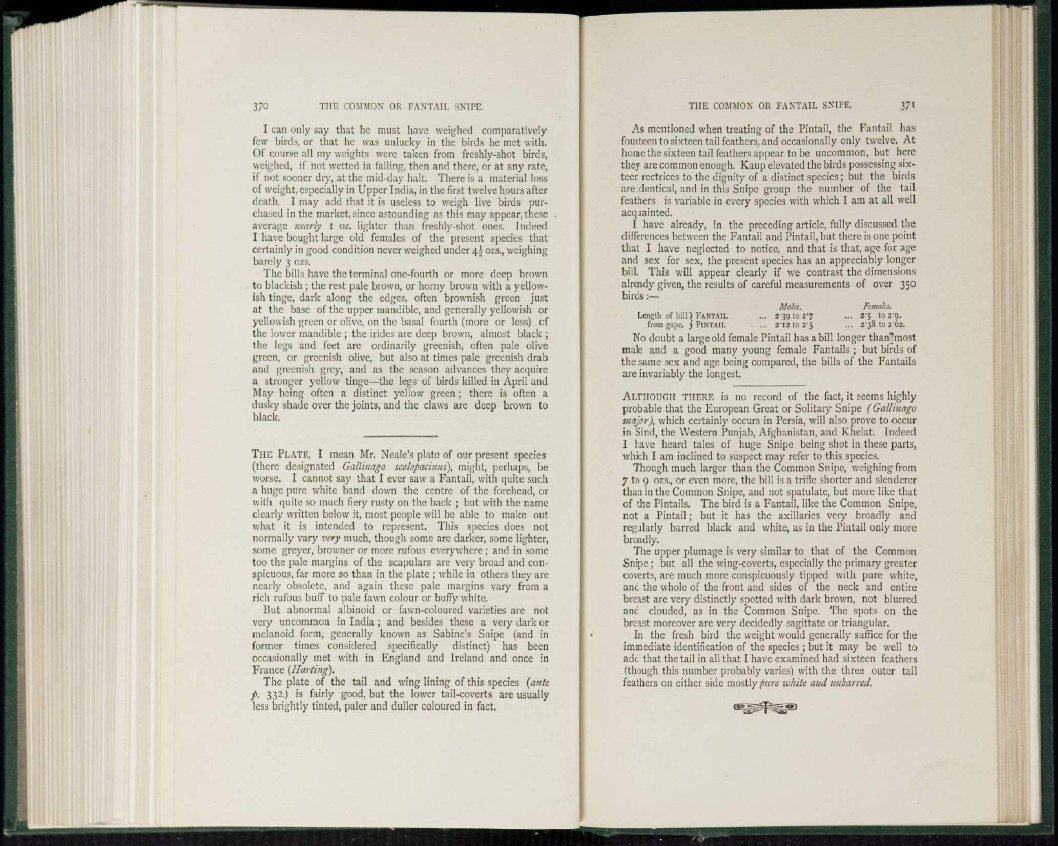
I can only say that he must have weighed comparatively
few birds, or that he was unlucky in the birds he met with.
Of course all my weights were taken from freshly-shot birds,
weighed, if not wetted in falling, then and there, or at any rate,
if not sooner dry, at the mid-day halt. There is a material loss
of weight, especially in Upper India, in the first twelve hours after
death. I may add that it is useless to weigh live birds purchased
in the market, since astounding as this may appear, these
average nearly I oz. lighter than freshly-shot ones. Indeed
I have bought large old females of the present species that
certainly in good condition never weighed under 4 $ ozs., weighing
barely 3 ozs.
The bills have the terminal one-fourth or more deep brown
to blackish ; the rest pale brown, or horny brown with a yellowish
tinge, dark along the edges, often brownish green just
at the base of the upper mandible, and generally yellowish or
yellowish green or olive, on the basal fourth (more or less) cf
the lower mandible ; the irides are deep brown, almost black ;
the legs and feet are ordinarily greenish, often pale olive
green, or greenish olive, but also at times pale greenish drab
and greenish grey, and as the season advances they acquire
a stronger yellow tinge—the legs of birds killed in April and
May being often a distinct yellow green ; there is often a
dusky shade over the joints, and the claws are deep brown to
black.
THE PLATE, I mean Mr. Neale's plate of our present species
(there designated Gallinago scolopacinus), might, perhaps, be
worse. I cannot say that I ever saw a Fantail, with quite such
a huge pure white band down the centre of the forehead, or
with quite so much fiery rusty on the back ; but with the name
clearly written below it, most people will be able to make out
what it is intended to represent. This species does not
normally vary very much, though some arc darker, some lighter,
some greyer, browner or more rufous everywhere ; and in some
too the pale margins of the scapulars are very broad and conspicuous,
far more so than in the plate ; while in others they are
nearly obsolete, and again these pale margins vary from a
rich rufous buff to pale fawn colour or buffy white.
But abnormal albinoid or fawn-coloured varieties are not
very uncommon in India ; and besides these a very dark or
mclanoid form, generally known as Sabine's Snipe (and in
former times considered specifically distinct) has been
occasionally met with in England and Ireland and once in
France {Harting).
The plate of the tail and wing lining of this species {ante
p. 332.) is fairly good, but the lower tail-coverts are usually
less brightly tinted, paler and duller coloured in fact.
As mentioned when treating of the Pintail, the Fantail has
fourteen to sixteen tail feathers, and occasionally only twelve. At
home the sixteen tail feathers appear to be uncommon, but here
they are common enough. Kaup elevated the birds possessing sixteen
rectrices to the dignity of a distinct species; but the birds
are identical, and in this Snipe group the number of the tail
feathers is variable in every species with which I am at all well
acquainted.
I have already, in the preceding article, fully discussed the
differences between the Fantail and Pintail, but there is one point
that I have neglected to notice, and that is that, age for age
and sex for sex, the present species has an appreciably longer
bill. This will appear clearly if we contrast the dimensions
already given, the results of careful measurements of over 350
birds:—
Males. Females.
Length of biin FANTAIL ... 2-39102-7 ... 2-5 102-9.
from gape, j PINTAIL ... 2-12 to 25 ... 2"38 to 2-62.
No doubt a large old female Pintail has a bill longer than^most
male and a good many young female Fantails ; but birds of
the same sex and age being compared, the bills of the Fantails
are invariably the longest.
ALTHOUGH THERE is no record of the fact, it seems highly
probable that the European Great or Solitary Snipe (Gallinago
major), which certainly occurs in Persia, will also prove to occur
in Sind, the Western Punjab, Afghanistan, and Khelat. Indeed
I have heard tales of huge Snipe being shot in these parts,
which I am inclined to suspect may refer to this species.
Though much larger than the Common Snipe, weighing from
7 to 9 ozs., or even more, the bill is a trifle shorter and slenderer
than in the Common Snipe, and not spatulate, but more like that
of the Pintails. The bird is a Fantail, like the Common Snipe,
not a Pintail; but it has the axillaries very broadly and
regularly barred black and white, as in the Pintail only more
broadly.
The upper plumage is very similar to that of the Common
Snipe ; but all the wing-coverts, especially the primary greater
coverts, are much more conspicuously tipped with pure white,
and the whole of the front and sides of the neck and entire
breast are very distinctly spotted with dark brown, not blurred
and clouded, as in the Common Snipe. The spots on the
breast moreover are very decidedly sagittate or triangular.
In the fresh bird the weight would generally suffice for the
immediate identification of the species ; but it may be well to
add that the tail in all that I have examined had sixteen feathers
(though this number probably varies) with the three outer tail
feathers on either side mostly pure white and unbarred.